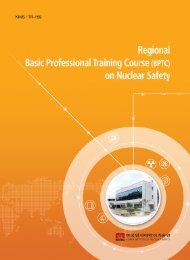PROSPER guidelines - Nuclear Safety and Security - IAEA
PROSPER guidelines - Nuclear Safety and Security - IAEA
PROSPER guidelines - Nuclear Safety and Security - IAEA
Create successful ePaper yourself
Turn your PDF publications into a flip-book with our unique Google optimized e-Paper software.
These <strong>guidelines</strong> have been developed to provide advice <strong>and</strong> assistance to utilities or<br />
individual power plants to strengthen <strong>and</strong> enhance their own operational experience process<br />
through critical self-assessment.<br />
By conducting a critical self-assessment of the process, OE may be optimised, leading to<br />
continuous improvement. This may be achieved through regular effectiveness reviews.<br />
Determination of whether the operational experience processes are being effectively managed,<br />
that the stated expectations <strong>and</strong> st<strong>and</strong>ards are being achieved, maintained, <strong>and</strong> improvement<br />
sought, <strong>and</strong> that significant generic issues are being adequately identified <strong>and</strong> timely rectified<br />
are the major objectives. The <strong>IAEA</strong>-led <strong>PROSPER</strong> review utilises the plant self-assessment as<br />
the basis for its evaluation. If a utility operates more than one NPP then it may also be<br />
appropriate to perform a self-assessment at the corporate level.<br />
The objective of an operational experience process is to ensure that all available information<br />
is properly used to improve operational safety. To achieve this objective it is necessary to<br />
ensure that:<br />
• the collection of information in timely manner is sufficiently comprehensive that no<br />
relevant data is lost (this requires broad reporting criteria <strong>and</strong> low detection thresholds);<br />
• the information collected is screened effectively to ensure that all important safety related<br />
issues, that should be reported <strong>and</strong> analysed with priority, will actually be identified (this<br />
requires clear ranking criteria);<br />
• the issues identified are analysed in sufficient depth to permit the identification of<br />
underlying root causes with respect to equipment, personnel <strong>and</strong> procedures,<br />
• the corrective actions are implemented in timely manner to prevent the recurrence of<br />
similar events caused by similar root causes;<br />
• the lessons learned are disseminated promptly <strong>and</strong> widely to enable other utilities in both<br />
nationally <strong>and</strong> internationally to take corrective actions before similar events occur.<br />
To ensure that the plant arrangements meet these objectives, it is necessary to carry out<br />
periodic self-assessments.<br />
2.2. AREAS FOR SELF-ASSESSMENT<br />
The guidance has been developed for the following areas of the self-assessment of the OE<br />
process (see more details in Table I):<br />
• strategy,<br />
• organization,<br />
• activities,<br />
• results,<br />
• effectiveness monitoring.<br />
Each self-assessment review area is subdivided into:<br />
• attributes,<br />
• documentation,<br />
• review topics.<br />
The “attributes” subsection gives desirable characteristics of an OE process relating to the<br />
review area.<br />
6
















